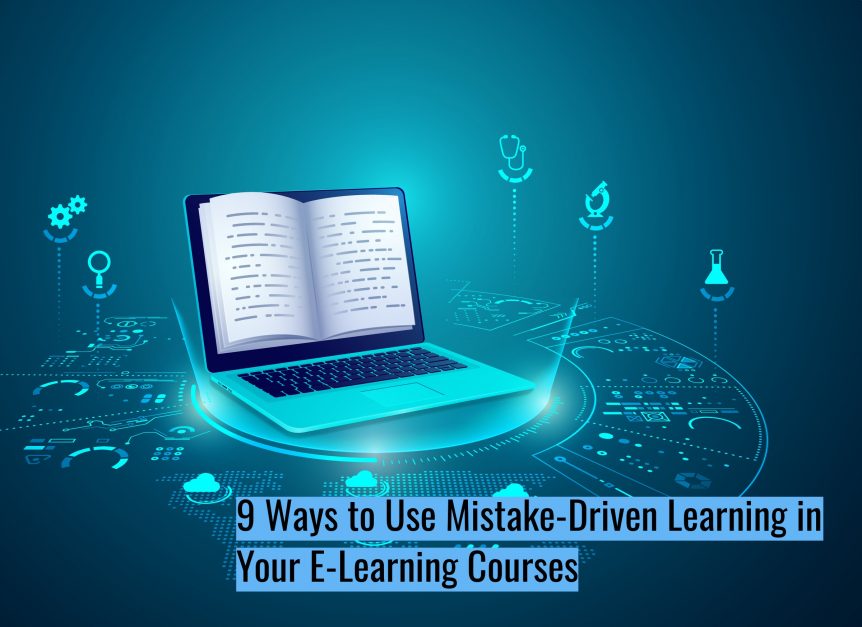9 Ways to Use Mistake-Driven Learning in Your E-Learning Courses
Making a mistake is a powerful learning experience. Mistakes can bring clarity to a topic, and they can correct wrong assumptions and misplaced understandings. They can also help plug knowledge gaps. Therefore, you can improve results and the overall quality of your e-learning courses by creating opportunities for mistake-driven learning experiences.
How do you strategically and deliberately integrate mistake-driven learning into your e-learning courses? Here are nine tips and methods you can use.
-
Use Quizzes as a Learning Tool
The objective of most quizzes in e-learning courses is to get as many correct answers as possible. So, quizzes are usually located at the end of a section or the end of a course where the primary objective is assessment.
However, you can also use quizzes as learning tools, where the objective of the quiz is to identify knowledge gaps and areas where the learner can improve. This involves taking a different approach to the quiz, an approach where correct answers are not the expected outcome.
When framed properly, quizzes can give learners a clear understanding of where they need to improve and what they need to do.
-
Include Branching Scenarios in Your E-Learning Courses
Branching scenarios are one of the best ways to integrate mistake-driven learning into your e-learning courses. They involve presenting learners with a situation where they then have to make decisions or take actions. Those decisions or actions have a knock-on effect, leading to further options for the learner to choose.
-
Include Mistakes as Options in Branching Scenarios
When creating options for branching scenarios, include realistic and plausible mistakes. It’s important when crafting options in branching scenarios that you avoid hand-holding the learner, guided them to the correct choice.
After all, the objective shouldn’t be the learner getting through the scenario successfully, so they reach the correct conclusion. It’s more important that they learn from the experience.
-
Make it Possible for Learners to Explore Consequences
This is back to branching scenarios again. When learners select the wrong option, don’t just tell them they are wrong. Instead, explain why the decision or action is wrong. It is even better if you can show them the consequences of their decision or action.
So, don’t dead-end incorrect options. Instead, let the learner proceed further through the scenario so they can see the potential impact of their choices.
-
Don’t Let Learners Stray Too Far
While the above point is important, don’t let the learner go too far down the wrong path. This will become distracting and could even be confusing.
The better approach is to let learners go just far enough so they can understand where they went wrong, why, and the resulting consequences.
-
Give Detailed, Constructive Feedback on Decisions and Actions
Simply marking an answer as wrong doesn’t do much to increase knowledge or understanding. It is the explanation of why the answer is wrong that delivers the learning experience, so make sure yours are detailed and relevant.
-
Allow Learners to Redo Scenarios
It’s also important that learners have the opportunity to try scenarios again when they make a mistake. They will be more comfortable going through the scenario if they know they can redo it, while correcting the mistake and getting to the right conclusion shows they have now grasped the topic.
Allowing learners to redo scenarios where they have previously made a mistake also lets them see the consequences of correct decisions and actions. This includes understanding the difference between the consequences of making an incorrect choice and the consequences of making the right choice.
-
Include Stories of Mistakes, Explaining How It’s Possible to Learn from Them
Quizzes and scenarios are not the only tools that add mistake-driven learning experiences to your e-learning courses. Including stories is another option, whether it is a text-based story, a video, or another media element.
The most obvious approach is for the story to highlight how someone was presented with a situation and took the wrong approach. You can then explain the consequences of the mistake and how it was rectified. You can also outline how it’s possible to learn from that mistake.
This method is not as powerful as creating situations where learners can learn from their own mistakes. However, stories add real-world relevance where the options, outcomes, and consequences are no longer theoretical.
-
Use Troubleshooting Tips and Guides Instead of Wizards
This tip goes back to an earlier point about hand-holding the learner through a course, section, content area, or skill. Wizards are a common way to do this.
In non-learning settings, wizards can be very beneficial. Using a new app is a good example as wizards help users get up and running quickly.
However, your objective in e-learning is to help people learn. Wizards can detract from that as learners simply have to do what they are told rather than having to think, assess, and understand.
Alternatives to wizards that you can use to provide help, guidance, and support include troubleshooting tips, tooltips, and guides.
Benefiting from Mistake-Driven Learning
The above methods and strategies will help improve your e-learning courses. This includes helping learners better understand how the content of the course matches their daily experience.
Mistake-driven learning also makes it possible for learners to experience challenging and possibly dangerous situations in a virtual and, therefore, safe environment. The approach also improves problem-solving capabilities and knowledge retention, and it can improve confidence.
These are all compelling reasons to include mistake-driven learning elements and opportunities in your e-learning courses.
